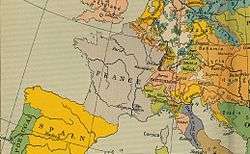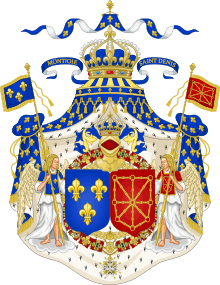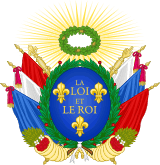Kingdom of France (1791–92)
| Kingdom of France | ||||||||||
| Royaume de France | ||||||||||
| ||||||||||
| ||||||||||
| Motto La Nation, la Loi, le Roi "The Nation, the Law, the King" | ||||||||||
 French Kingdom before its demise | ||||||||||
| Capital | Paris | |||||||||
| Languages | French | |||||||||
| Religion | Roman Catholicism | |||||||||
| Government | Constitutional monarchy | |||||||||
| King of the French | ||||||||||
| • | 1791–1792 | Louis XVI | ||||||||
| Legislature | Legislative Assembly | |||||||||
| History | ||||||||||
| • | Constitution adopted | 3 September 1791 | ||||||||
| • | Storming of the Tuileries | 10 August 1792 | ||||||||
| • | Republic proclaimed | 21 September 1792 | ||||||||
| Currency | Assignat | |||||||||
| ||||||||||
A short-lived constitutional monarchy governed France from 3 September 1791, until 21 September 1792 when the Kingdom of France was succeeded by the First Republic. This regime was France's first constitutional monarchy. The Legislative Assembly suspended the monarchy on 11 August after the Storming of the Tuileries Palace.[1] The freshly elected National Constituent Assembly abolished the monarchy on 21 September 1792 ending 203 years of consecutive Bourbon rule over France.
Background
France had been undergoing a revolution in its government and social orders. A National Assembly declared itself into being and promulgated their intention to provide France with a fair and liberal constitution.[2] Louis XVI moved to Paris in October of that year but grew to detest Paris and organised an escape plot in 1791. The escape plot known as the Flight to Varennes ultimately failed to materialise and destroyed any positive public opinion for the monarchy.[3] Louis XVI's brothers-in-exile in Coblenz rallied for an invasion of France. Austria and Prussia responded to the royal brothers' cries and released the Declaration of Pillnitz in August. The declaration stated that Prussia and Austria wished to restore Louis XVI to absolute power but would only attempt to do so with the assistance of the other European powers.[4]
Constitution
Louis XVI was forced to adopt the Constitution of 1791 by the National Assembly in the aftermath of his Flight to Varennes to the Austrian Netherlands.[5] The Constitution of 1791 which established the Kingdom of the French was revolutionary in its content. It abolished the nobility of France and created all men equal before the law. Louis XVI had the ability to veto legislation that he did not approve of as the legislation still needed Royal Assent to come into force.[6]
Republic
Louis XVI reluctantly declared war on Austria on 20 April 1792 bowing to the assembly's wishes. Prussia allied with Austria and therefore France was at war with Prussia as well.[7] The Brunswick Manifesto of August 1792 issued by the Duke of Brunswick, Commander of the Austrian and Prussian military brought about the Storming of the Tuileries on 10 August 1792. The manifesto explicitly threatened the people of Paris with dire repercussions if they in any way harmed Louis XVI or his family.[8] The Legislative Assembly was inundated with requests for the monarchy's demise. The President of the National Assembly responded by suspending the monarchy on 11 August pending the outcome of elections for another assembly.[1] The newly elected National Convention elected under universal male suffrage abolished the monarchy on 21 September 1792. The convention proclaimed a republic.[9]
See also
Citations
References
- Fraser, Antonia: "Marie Antoinette: the Journey", Orion Books, London, 2001, ISBN 978-0-7538-1305-8
- Hibbert, Christopher: "The French Revolution", Penguin Books, Great Britain, 1982, ISBN 978-0-14-004945-9
- Jones, Colin: "The Great Nation: France from Louis XV to Napoleon", Columbia University Press, New York, 2002, ISBN 0-231-12882-7
.svg.png)

